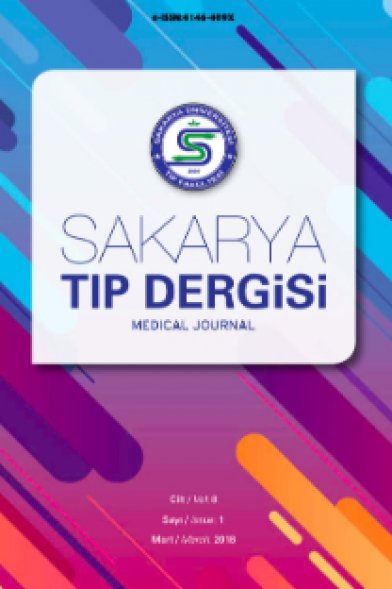Complementary, Alternative and Conventional Medicine Attitude Scale: Turkish Validity Reliability Study
Complementary medicine, traditional medicine, scale, validity and reliability
___
- 1. McFadden KL, Hernandez TD, Ito TA, Attitudes toward complementary and alternative medicine influence its use, EXPLORE November/December 2010, Vol. 6, No. 6, p 380-388
- 2.Baer H. The emergence of integrative medicine in Australia: The growing interest of biomedicine and nursing in Comcomplementary medicine in a southern developed society. Med Anthropol Q 2008;22:52-66.
- 3.Khalaf AJ, Whitford DL. Theuse of complementaryandalternativemedicinebypatientswithdiabetesmellitus in Bahrain: A cross-sectionalstudy. BMC ComplementAlternMed 2010;10:35.
- 4.Eisenberg DM, Kessler RC, Foster C, Norlock FE, Calkins DR, Delbanco TL. Unconventionalmedicine in the United States. Prevalence, costs, andpatterns of use. N Engl J Med 1993;328:246-52.
- 5.FisherandWard (1994). Complementarymedicine in Europe. BMJ 1994 Jul;309(6947):107-111.
- 6.Betthauser LM, Brenner LA, Forster JE, Hostetter TA, Schneider AL, Hernandez TD, A Factor Analysis and Exploration of Attitudes and Beliefs Toward Complementary and Conventional Medicine in Veterans, Medical Care, Volume 52, Number 12 Suppl 5, December 2014, p 50-56.
- 7.Davis, L.L. Instrument review: Getting the most from a panel of experts. Applied Nursing Research, 1992, 5, 194-197.
- 8.Alpar R, Uygulamalı Çok Değişkenli İstatistiksel Yöntemler, 4.Baskı, Ankara, s 269-302, 849.
- 9.Erkorkmaz Ü, Etikan İ, Demir O, Özdamar K, Sanisoğlu SY, Doğrulayıcı Faktör Analizi ve Uyum İndeksleri, Türkiye Klinikleri J MedSci 2013;33(1), s 210-223.
- 10..Tezbaşaran A. Likert Tipi Ölçek Geliştirme Kılavuzu.İkinci baskı, Ankara, Türk Psikologlar Derneği, 1997.
- 11.Bhattacherjee A, Social Science Research: Principles, Methods, and Practices, p:56-58, 2012, ISBN-13: 978-1475146127
- 12. Schneider CD, Meek PM, Bell IR, Development andvalidation of IMAQ: IntegrativeMedicineAttitudeQuestionnaire, BMC MedicalEducation 2003, http://www.biomedcentral.com/1472-6920/3/5
- 13.Ergin A, Hatipoğlu C, Bozkurt Aİ, Mirza E, Kunak D, Karan C, Özçelik G, Teğin C, Pazır Y, Pırtı İ, Knowledge andattitudes of residentsandmedicalstudents on complementary-alternativemedicine, Pam Tıp Derg 2011;4(3):136-143.
- 14.Hyland ME, Lewith GT, Westoby C. Developing a measure of attitudes: the holistic complementary and alternative medicine questionnaire. Complement Ther Med. 2003 Mar;11(1):33-8
- 15.Desylvia D, Stuber M, Fung CC, Bazargan-Hejazi S, Cooper E. (2011) TheTheknowledge, attitudesandusage of complementaryandalternativemedicine of medicalstudents. EvidBasedComplementAlternatMed. 2011:728902. doi: 10.1093/ecam/nen 075.
- 16.Tanrıöğen A. Bilimsel Araştırma Yöntemleri, 3. Baskı. Ankara, Anı Yayıncılık, 2012: 172. Kültürlerarası ölçek uyarlaması için rehber I: Ölçek uyarlama aşamaları ve dil uyarlması, Aksayan S, Gözüm S, Hemşirelik Araştırma Dergisi 2002-4(1).
- 17.Aksayan S, Gözüm S.(2002). Kültürlerarası Ölçek Uyarlaması İçin Rehber I: Psikometrik Özellikler ve Kültürlerarası Karşılaştırma. Hemşirelik Araştırma Geliştirme Dergisi;4(2):9-13.
- 18.Kalaycı, Ş. (2010), Faktör Analizi, Ed. Şeref Kalaycı, SPSS Uygulamalı Çok Değişkenli İstatistik Teknikleri, Asil Yayın Dağıtım Ltd. Şti. Ankara.
- 19. Erci B, Attitudes towards holistic complementary and alternative medicine: a sample of healthy people in Turkey, Complementary and alternatıve medıcınes, Journal of ClinicalNursing, 16, 761–768,2007, doi:10.1111/j.1365- 2702. 2006. 01655.x.
- 20.Lie DA, Boker J. (2006) Comparativesurvey of complementaryandalternativeMedicine (CAM) attitudes, use, andinformation-seekingbehaviouramongmedicalstudents, residents&faculty, BMC MedEduc. 2006 Dec 9;6:58.
- 21.Chaterji R, Tractenberg RE, Amri H, Lumpkin M, Amorosi SB, Haramati (2007) A large-samplesurvey of first- andsecond-yearmedicalstudentlarge-samplesurvey of first- andsecond-yearmedicalstudentattitudestowardcomplementaryandalternativemedicine in thecurriculumand in practice. AlternTherHealthMed. 2007 Jan-Feb;13(1):30-5.
- 22. Kalaycı, Ş. (2010), Faktör Analizi, Ed. Şeref Kalaycı, SPSS Uygulamalı Çok Değişkenli İstatistik Teknikleri, Asil Yayın Dağıtım Ltd. Şti. Ankara.
- 23. Tavakol M, Dennick R, Making sense of Cronbach’s alpha, International Journal of Medical Education. 2011; 2:53-55 24.Pettersen S, OlsenRV.ExploringPredictors of HealthSciencesStudents’ AttitudesTowardsComplementary-AlternativeMedicine, AdvHealthSciEducTheoryPract (2007) 12: 35. doi:10.1007/s10459-005-3054-1.
- 25.Ventola L 2010, Current Issues Regarding Complementary and Alternative Medicine (CAM) in the United States Part 1: The Widespread Use of CAM and the Need for Better-Informed Health Care Professionals to Provide Patient Counseling, Vol. 35 No. 8 • August 2010 • P&T, 461-68
- 26.Xue CC, Zhang AL, Lin V, Da Costa C, Story DE. Complementary and alternative medicine use in Australia: A national populationbased survey. J Altern Complement Med 2007;13:643-50.
- 27.Harmon S, Ward CB. Complementary And Alternatıve Medıcıne: Awareness And Attıtudes. AHCMJ, Volume 3, Number 1, 2007
- 28.Saydah SH, Eberhardt MS. Use of complementary and alternative medicines among adults with chronic disease: United States 2002. J Altern Complement Med 2006;12:805-12.
- Yayın Aralığı: 4
- Başlangıç: 2011
- Yayıncı: Sakarya Üniversitesi
İnfantlarda Görülen Kalsiyum Yüksekliğinin D Vitamini ile İlişkisi
Abdullah YAZAR, Fatma ŞAMLIOĞLU, Fatih AKIN, Şükrü ARSLAN
Aleksinin Eşlik Ettiği Gerstmann Sendromu Olgusu
Abdulkadir TUNÇ, Yonca ÜNLÜBAŞ
Metastatik Prostat Kanserinde Nobiletinin Sitotoksik ve Apoptotik Etkisinin Belirlenmesi
Gamze Güney Eskiler, Asuman DEVECİ ÖZKAN, Süleyman KALELİ
Üniversite Öğrencileri Akıllı Telefona Bağlanıyor mu?
Şeyda TOK, Nida ERDOĞAN, Hasan Çetin EKERBİÇER, Ufuk BERBEROĞLU
Elif KÖSE, Hasan Çetin EKERBİÇER, Ünal ERKORKMAZ
Amyotrofik Lateral Skleroz Tanısı ile Takip Edilen Hastada Siringomiyeli
Emel Oğuz Akarsu, Bekir Enes Demiryurek
Determination Of State Of Women To Have Pap Smear Test And The Associated Factors
Gartland Tip III Suprakondiler Humerus Kırıklarının Cerrahi Tedavisi Ne Zaman Yapılmalı?
Alauddin KOCHAİ, Turgut AKGÜL, Barış GÜLENÇ, Fevzi BİRİŞİK, Gökhan POLAT, Önder YAZICIOĞLU
Akut Gastroenteritli Hastalarda Rotavirüs ve Adenovirüs Sıklığının Araştırılması; Sakarya
Hüseyin Agah TERZİ, Özlem AYDEMİR
Kronik Kolesistit Hastalarında Safra Kesesi IGF-1 Ekspresyonu Ve Kan CRP Düzeyi İlişkisi
